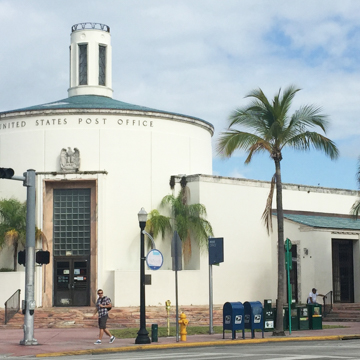By 1936, Miami Beach had become one of the first municipalities to emerge from the Great Depression. The combination of one of the newest and advanced systems of roadways, inexpensive accommodations, effective municipal advertising, and mild winter weather brought visitors in droves, stimulating the construction of what would become the Miami Beach Architectural District (also known as the “Art Deco District”), the largest concentration of resort architecture from the 1920s and 1930s in the United States. This groundswell of visitors prompted the Miami Beach Chamber of Commerce to pursue the idea of acquiring land and constructing Miami Beach’s first freestanding post office building.
Hired to design the structure was Chicago-born Howard L. Cheney of the Office of the Supervising Architect of the U.S. Treasury, who, at the same time, was also working on the Federal Building and Court of Peace at the New York World’s Fair of 1939–1940, the National Airport in Washington, D.C., and buildings on the campus of the University of Illinois in Urbana. Cheney had mastered a style of functional modernism in all of his buildings of this period, eschewing excessive decoration in favor of a clean, classically monumental modern architecture designed around programmatic and functional requirements.
After a considerable discussion about whether the building would be surfaced with Florida limestone or architectural concrete (the former was selected), the construction contract was awarded in September 1937 and the cornerstone laid in February 1938, with the dedication ceremony held in July. Although the building opened in 1939, final touches were completed the following year.
From the busy street corner on which the post office is located, the building appears to be constructed around three elements: a two-story, central cylinder topped by a circular cupola; a wing with an open arcade for public entry along Washington Avenue; and a wing along Thirteenth Street containing the sorting facilities. Along Washington Avenue, the building is set back, providing a small planted area that allows the post office to remain oriented on the regular grid of the city to the west, while also accommodating the angle of Washington Avenue and streets east, which are aligned with the beach itself. This area affords space on the north for an intricate fountain featuring a jumping fish as well as a long series of red Etowah marble steps that lead up to the arcaded entry doors. Covering the roof of the arcade, the pediment in the northernmost area of the building, and the rotunda are bright blue Ludowici Celadon tiles. Set near the edge of the roof of the rotunda are six square tile medallions—an unusual design feature since they are not visible from the street.
Through the monumental doorway centered between two planters is one of the most spectacular historic interiors in Florida. The ceiling is painted bright aquamarine with white dots radiating from a central geometric light fixture that is outlined with licks of flame in a representation of the sun. Around the edges of the ceiling are wavy bands of bronze that reference the gleaming bronze post office boxes embedded into the faceted walls. Below the central light fixture is a simple, circular blue fountain. Mounted within this cosmology of sun and the water—and directly above the post office boxes—are the enormous and athletic, scantily clad male bodies depicting Native Americans as they battle and are subjugated by fully clad western conquerors. WPA muralist Charles Hardman had initially proposed a similar scene for another mural competition and was encouraged along this path by his supervisors in Washington, D.C. Reminiscent of a Roman temple at the outskirts of the empire, the muscularity of these murals, the forceful monumentality of this architecture, the narrative of the subject matter, and the complexities of the architectural details, point to interesting tensions and collisions between center and periphery in the United States as the country prepared to enter World War II.
References
Stuart, John A., and John F. Stack, Jr., eds. The New Deal in South Florida: Design, Policy and Community Building, 1933-1940. Gainesville: University Press of Florida, 2008.

